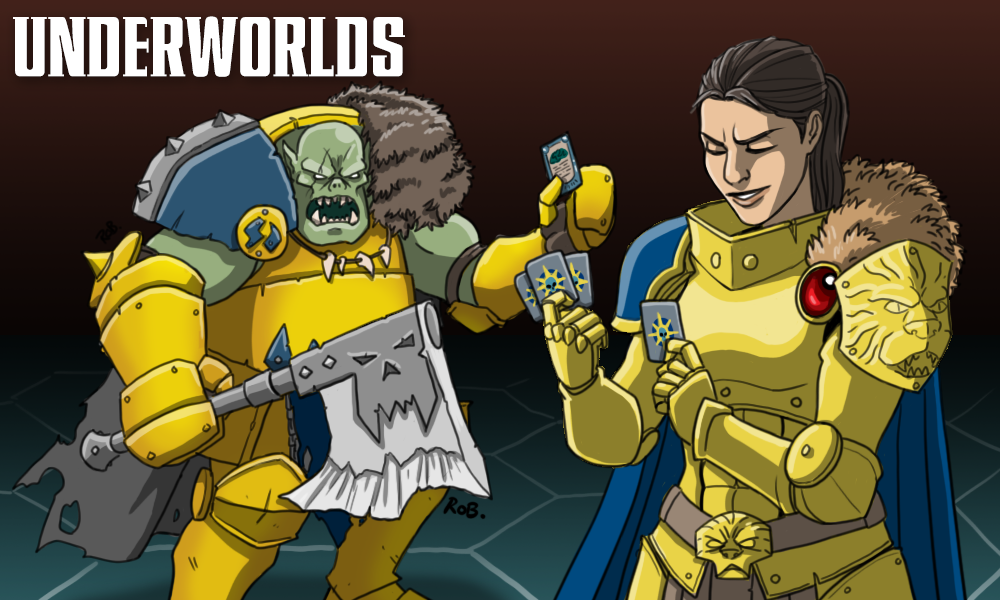Warhammer Underworlds is billed as the “Ultimate Competitive Miniatures Game” by Games Workshop. That’s a fair description in many respects. While there have always been (and always will be) warbands and cards that overperform or underperform, we’ve had 3 exciting seasons of tense dice-fueled combat. Born in the pages of White Dwarf, Arena Mortis has arrived to blow up the Underworlds. This single-model multiplayer melee mode utterly breaks the game, and is all the more fun for it.
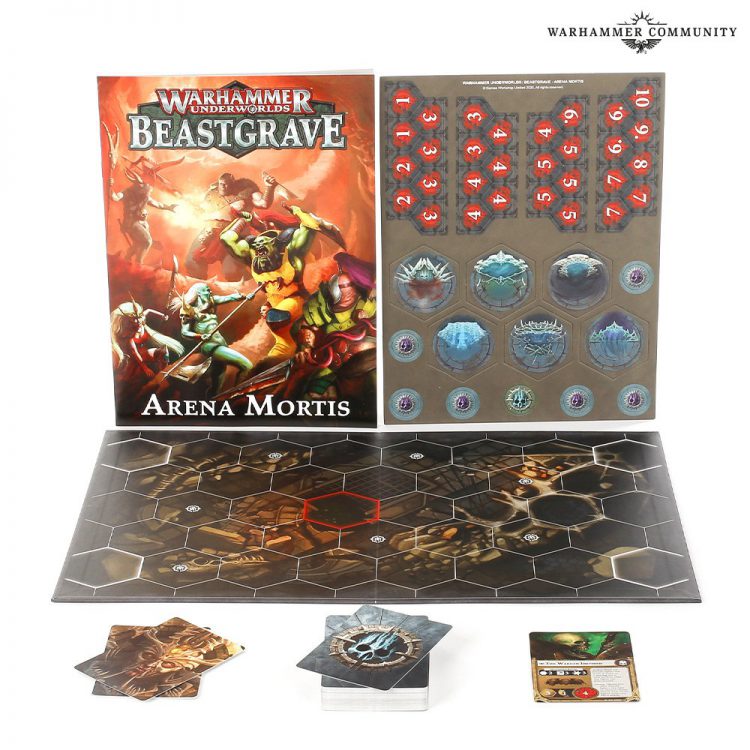
I’ve played hundreds of games of Underworlds; blowouts are rare and it’s far more common to have games hinging on key movements or attacks. Most warbands have a build or two that can be piloted to success, and evenly matched players can expect a tense gaming experience. In short, the game is pretty well balanced. However, balance isn’t always all it’s cracked up to be.
In a quest for balance, designers and players will often eschew wild swings in favor of consistency. From an expected value perspective, a card that has a 100% chance of doing 1 damage is identical to a card that has a 10% chance of dealing 10 damage. These could be called balanced. However, from a game impact perspective the 10 damage card is a whole different beast. A card that can one-shot the biggest fighters in the game becomes something that has a near 10% chance of winning you the entire game. Balance has to consider consistency and variance, not just expected value.
It’s for such reasons that the term “broken” enters players’ vocabulary. The impact of such an effect can be dramatic and swingy. Spiteful Lunge is a universal card that comes in the Arena Mortis expansion that is already driving some players up the wall. Once equipped, that fighter has a 1/6 chance of removing an enemy model from the battlefield. It’s rare enough that you likely don’t want to plan around it, but when it triggers it can seal the game against a Mollog or Hrothgorn player in a way that—to some players—is unsatisfying.
I am not one of those players.
I adore “broken” games and broken cards because I do not believe that “broken” and “balanced” are diametric opposites. I believe that clever design can allow for every player to revel in the extreme and still deliver a compelling game experience. Cthulhu Wars is one such board game; the asymmetry in faction powers is so dramatic that everything an opponent does feels unfair and everything you do feels like you might be cheating. However, it’s still a balanced game. When everything is so powerful as to feel broken, then nothing is overpowered.
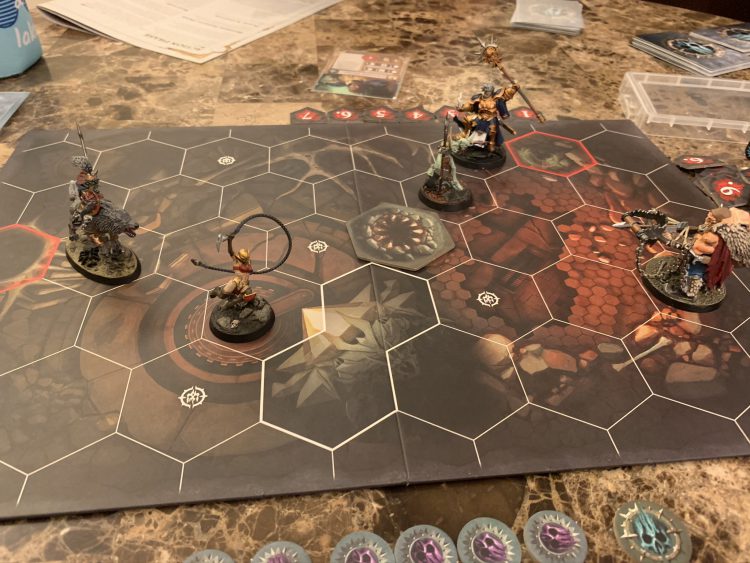
That is what a game of Arena Mortis feels like. Gone are silly restrictions like “needing to have some glory to play upgrades” or “that combo depends on too many pieces”. Arena Mortis rewards you for leaning into the extreme, for identifying busted combos and deploying them on your unsuspecting pals. Imagine a Khamyss who can’t be attacked by Range 1 attacks, because she’ll interrupt every time and either kill you first or knock you back. Imagine a Stormsire who is standing 3 hexes away and attacking for 3 damage, 4 if it’s against a high-wound model, 5 with a crit, and up to 7 (!) with the right set up!
Underworlds is full of extreme situations that are possible though unlikely. With the exception of a few “Voltron” builds, loading up individual fighters has not been an effective gameplan. It takes quite a bit of glory which is often best spread around to multiple fighters, and the need for all that glory would also mean that by the time you could assemble your Voltron you’d have already won. Good deck design is about getting that glory, not depending on a setup that requires you to already have it.
The biggest change in Arena Mortis eliminates that. In a game of Mortis, your upgrades and gambits are separated into two decks. Upgrades no longer enter your hand to be played once you have glory. Instead, your fighter begins the game with a few already in play and gains a new one every round—this is also free. Any gambits that give additional upgrades will also apply a fresh upgrade from the top of the deck. Suddenly complicated set-ups become something you can plan around. Those extreme situations go from unlikely to probable.
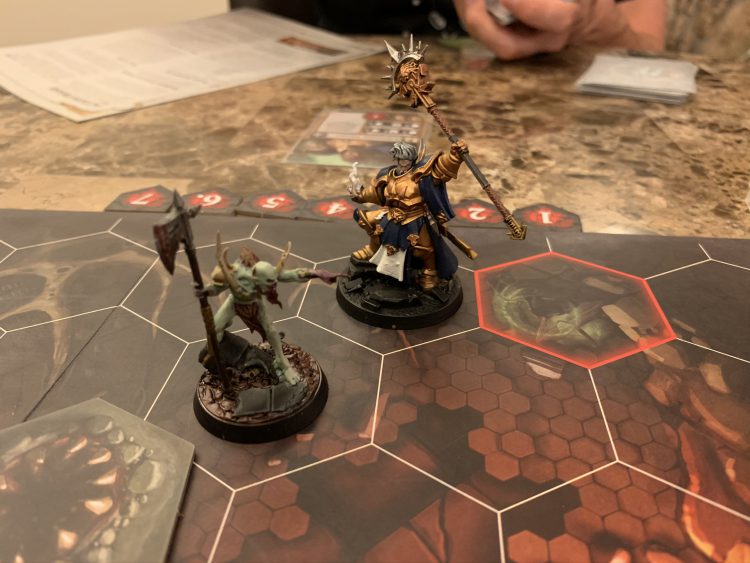
The Combo keyword in particular can come to life in a game of Mortis. Low-wound models begin the game with 3 upgrades, meaning equipping your fighter with Combo cards and Combo-Reaction finishes becomes an inevitability. Not only will you have the opportunity to play them, the fact that your fighter comes back every round means you’ll actually get to use them. Arena Mortis takes all the 5-card dream combos we build in our hearts and finally allows our heads to embrace them as well.
There are, however, a couple of pain points. The first is the potential to build out some un-fun experiences. In a recent game, I loaded Khamyss up with quite a few +damage, +dice, and Combo cards. I was dishing out multiple 4+ damage attacks per round. I also had Prescient Blow which allowed me to interrupt any Range 1 attack with both Prescient Blow and my innate Bladed Buckler combo finisher; this gave me 2 chances to either kill my opponent or drive them back before I could take any damage. Even if they gotten through that, a bevy of + Defense upgrades meant I was rolling 4 dice.
On its own, this is manageable. There are tricks. But the other catch with Mortis is that there is only 1 objective. All fighters are funneled towards the center objective where your various super-powers mean that you’re often standing next to each other rolling dice back and forth. Yes, all of you are combining various powers to roll handfuls of dice at a time, but when everyone is so broken that nobody is broken the net effect can be a whole lot of nothing. In my Khamyss game, the objective I stood on also prevented me from being the target of gambits. I was the rock and the hard place, the immovable object (she can’t be driven back) and the unstoppable force.
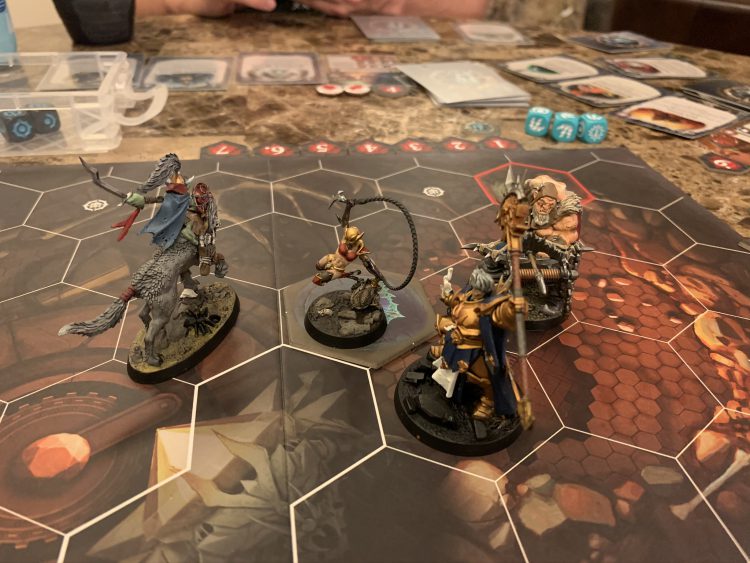
Mortis has a built in catchup mechanism and no fighter can survive the full focus of the entire table, but there were enough frustrating moments for the table that it’s worth pointing out that this game mode will likely not replace regular Underworlds for any group. While I would consider running tournaments or events for it, played competitively it will not be everyone’s chalice of blood. The extremes are so powerful that high level play will require access to cards no longer in print, and the attention span to sit down and consider thousands of cards. This dramatically increases the gulf between experience players will full playsets and players getting started. I had initially thought that this would be a fun game mode for introducing and teaching new players, but I failed to recognize that an easy-to-pilot deck would get absolutely destroyed by a full on Mortis deck.
For most players Arena Mortis, will serve as a card-expansion only. I hope that you consider the game mode as well. It’s fun to let your hair down every now and then. Arena Mortis breathes life into fun deck concepts, wild combos, and lets you ride the variance lightning. When structured appropriately, “brokeness” can be embraced instead of avoided. Arena Mortis—while neither perfect nor a replacement for standard Underworlds—is structured appropriately. Let’s get weird.
